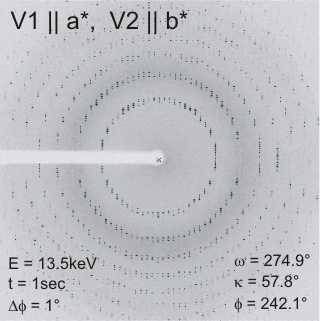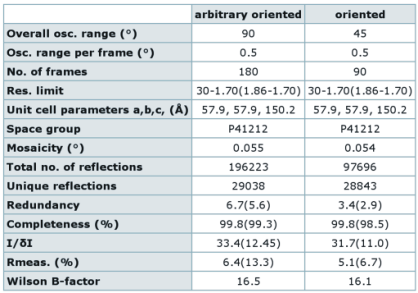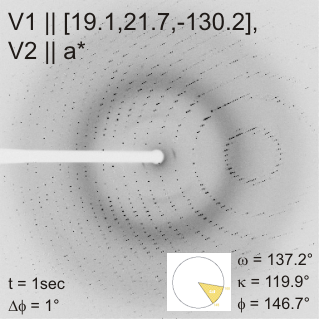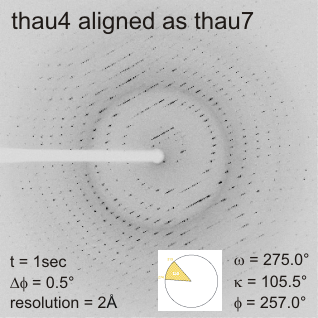Joint Research Group Macromolecular Crystallography
Alignment Scenarios
For crystal alignment, i.e. the calculation of the orientation specific motor values and crystal movement, the software package STAC is used, which has been developed by S. Brockhauser at EMBL-Grenoble. The figure shows the vector definition within STAC needed for proper choice of requested orientation. The spindle axis is equivalent to the ω-axis, i.e. the high precision air-bearing axis of the MD2.
Standard cell alignment
This is the option to align a reciprocal unit cell vector (a*, b*, c*) along the beam. Orientations with one axis aligned along V1 (spindle, i.e. primary rotation axis ω) and the second axis along V2 are calculated. For orthogonal systems V2 is parallel to the X-ray beam.
Use case
This scenario is mainly used to check the quality of the derived orientation matrix and instrument calibration, i.e. the description of the initial orientation of the crystal as mounted. For the anticipated alignment, this option produces highly symmetric diffraction images with concentric lunes.
Smart spot separation
With this option, the optimal orientation is calculated for maximum spot separation while minimizing the impact of the blind region. The long cell axis is as close as possible aligned parallel along V1 (ω) but tilted by θmax_resolution to prevent falling into the blind region.
Use case
This type of alignment is essential for data collection from crystals with an elongated unit cell to minimize spot overlap.
It should be the default alignment option, as maximum spot separation does improve data quality by increasing the oscillation increment and subsequent decreasing systematic errors in all kinds of data collection.
Smallest overall oscillation
Using Smalllest overall oscillation, the optimal orientations are calculated for minimizing the total angle of the data collection wedge. Boundary conditions of the calculation are the space group, the resolution and the completeness of the data set.
Use case
This option should be used for crystals which are extremely radiation sensitive. By utilizing crystal alignment together with strategy calculation, the completeness of the data collection can be significantly increased at the expense of redundancy. The example illustrates the reduction of the overall oscillation range needed for 100% completeness in case of space group P41212.
Multi-crystal reference
Within this option, the orientation of a previously mounted crystal is fetched to allow the alignment of a similar but freshly mounted crystal in the same orientation.
Use case
This scenario enables the combination of diffraction data from a multitude of isomorphous crystals of the same macromolecule in a very effective way, being valuable especially if radiation sensitivity limits the data collection. By utilizing referenced orientation together with strategy calculation, a data collection can be continued with no or only small overlap between consecutive data sets from different crystals.
Anomalous data collection
Within this scenario the orientations with 2-, 4-, or 6-fold axis aligned along V1 (spindle) are calculated as a function of the space group to be able to bring the Bjivoet pairs to the very same image.
Use case
This option should be used to minimize the systematic errors of a data collection while recording the weak anomalous signal on the same diffraction image. Systematic errors are the increasing influence of radiation damage during the course of data collection, beam position drifts, crystal anisotropy and others.







